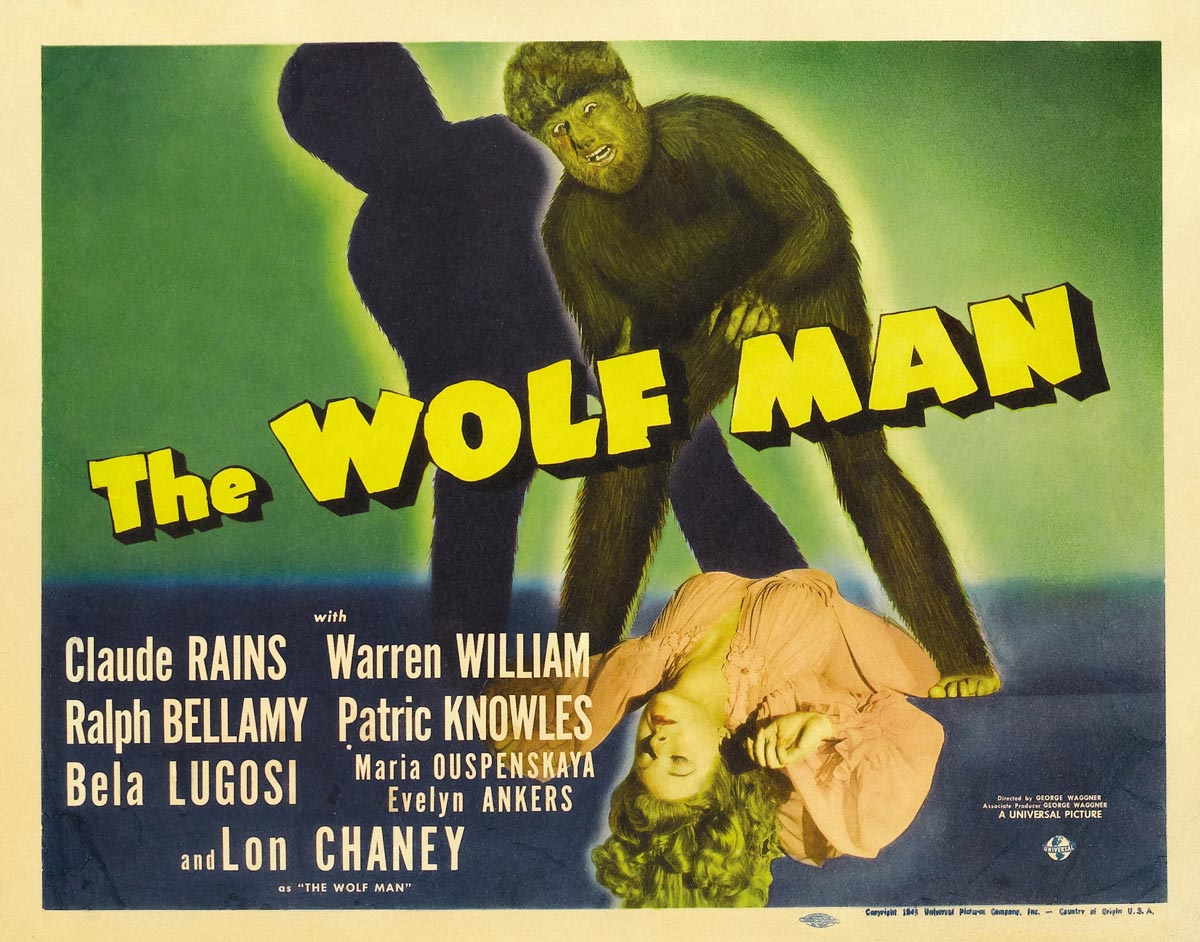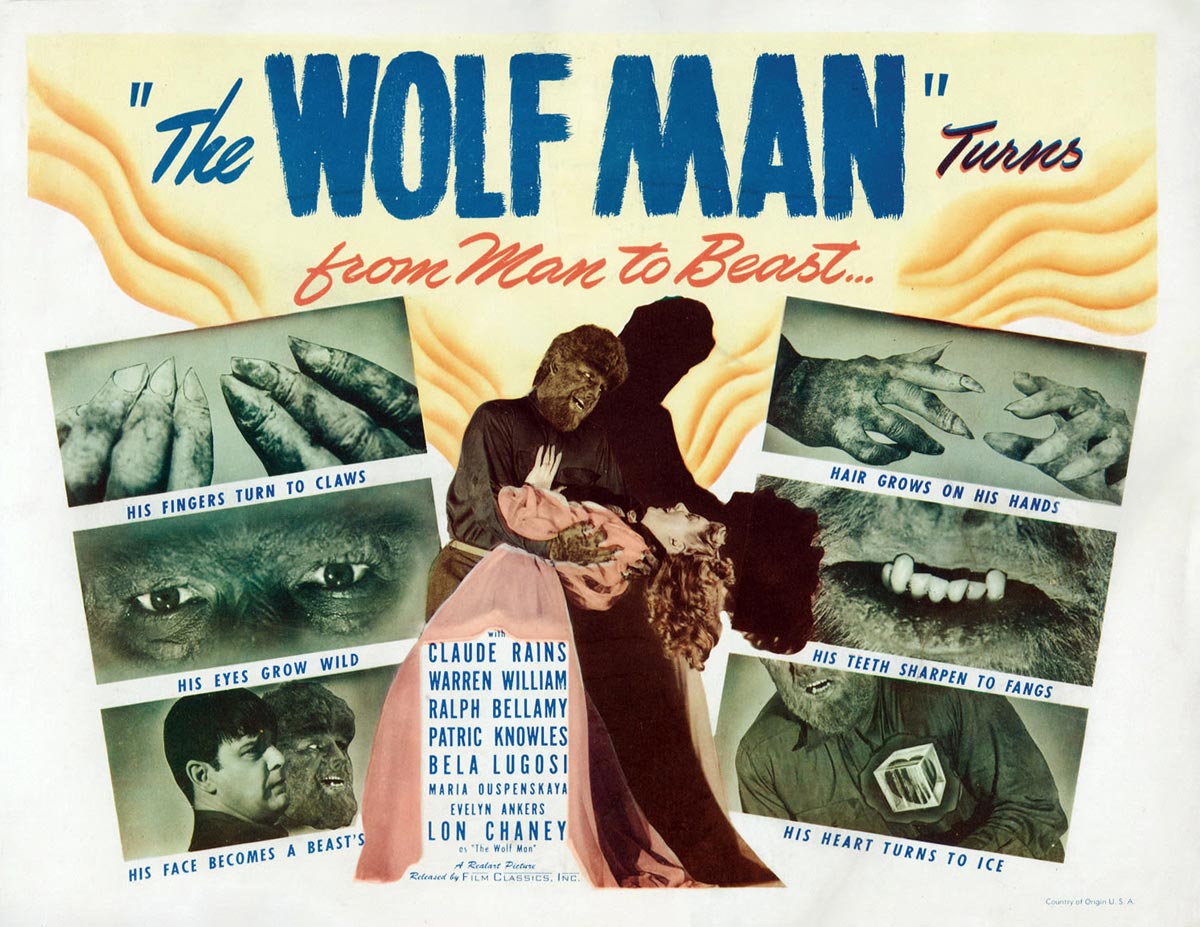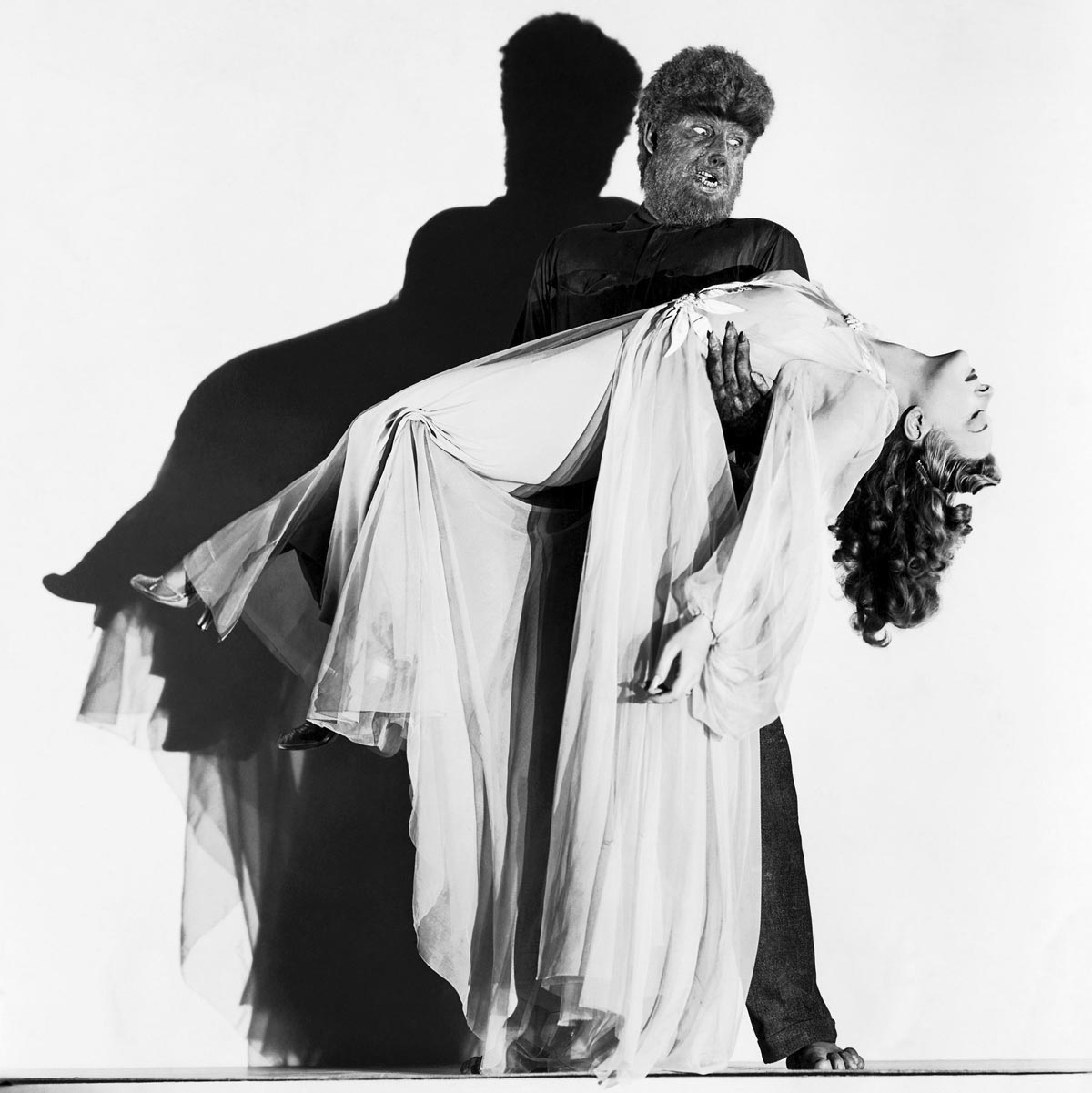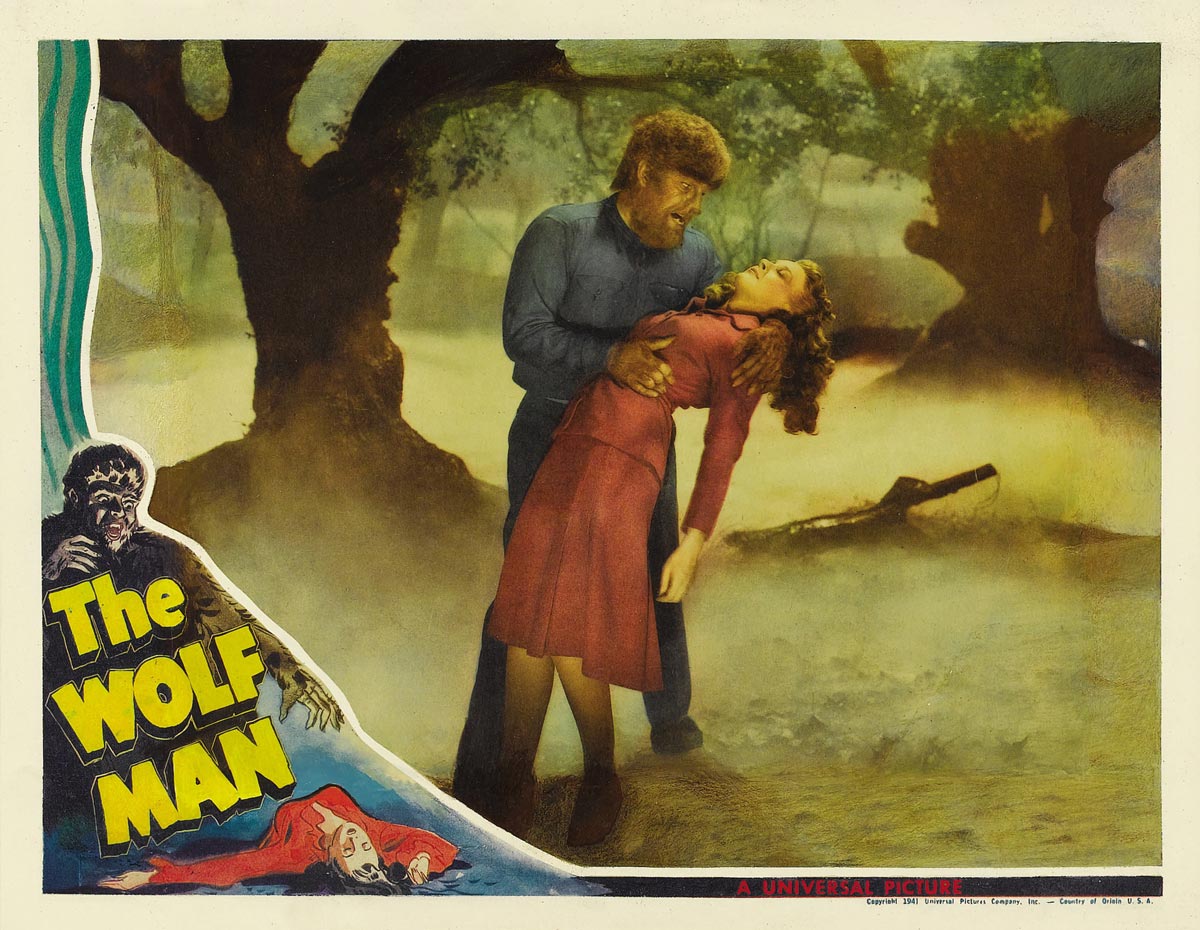Even a man who is pure in heart, and says his prayers by night; May become a wolf when the wolfbane blooms and the autumn moon is bright.
Lon Chaney Jr. does not look like the son of Claude Rains. Not only does he not look like Rains physically, with his tall stature and everyman awkwardness, but with his voice, his sometimes-lumbering carriage, his lack of suaveness and his sad, lost eyes that seem to be perpetually looking for a father figure, or a lover, or a soft bunny rabbit to hold – anything to sooth what haunts this man underneath his “normal” exterior. Something is missing within him, and we’re not sure what, but in Chaney Jr.’s best performances, that lost boy quality makes him immensely moving (watch Lewis Milestone’s Of Mice and Men). And, so, in George Waggner’s The Wolf Man, Chaney Jr.’s genetic disparity with elegant Rains works – it immediately sets up a distinction with a dad he left (fled from?) eighteen years earlier for reasons we’re not entirely certain of, and it makes us sympathetic to both him and his father – a father who is quietly grieving the loss of his older son. The Claude Rains dad (Sir John Talbot) clearly loves the Chaney Jr. son (the very average-Joe-named Larry), even if his son is, perhaps, the black sheep of the family, the outcast, and the father has a feeling why his son took off all of those years ago: sibling rivalry. Perhaps he’s right. Perhaps not? We don’t know. It takes the death of Larry’s brother (who looks exactly like Larry) to make him return with the idea to run the estate. Is that the only reason? Did he really miss his father? Why on earth was he gone for nearly 20 years? Is there something wrong … with him?

In the movie’s opening scene between Larry and Sir John, father discusses his living son’s estrangement frankly, something that could seem obvious; to be spelling it out so succinctly, but is instead, refreshing in its simultaneous directness and mystery. Sir John dives right into the possible wedge between them and wishes it would cease, but it’s from Sir John’s viewpoint, and we never learn what Larry might have endured. Perhaps the home life was awful. Perhaps his brother was a terrible person. As Sir John pokes at a fire in his grand, Welsh estate with the dead older son, John Jr.’s, portrait hanging ominously above, Larry sits down and listens to the psychological musings of his father. Rains talks with him, not angrily, just directly, and it’s a nicely realized moment:
Sir John: You know, Larry, there’s developed what amounts to a tradition about the Talbot sons. The elder, next in line of succession and so forth is considered in everything. The younger, frequently resents the position in which he’s found and leaves home, just as you did.
Larry: Yes, but I’m here now.
Sir John: Fortunately. But isn’t it a sad commentary on our relationship that it took a hunting accident and your brother’s death to bring you?
Reading this could almost sound passive aggressive, but it’s not. Rains’ crispness and warmth is merely telling his son the way he sees things, that he’s thought about this, and that he takes the blame too. In terms of his child-rearing and what has been expected of the sons, Sir John continues:
Sir John: The whole tradition is the Talbot’s be the stick necked un-demonstrative type. Frequently this has been carried to very unhappy extremes.
Larry: Don’t I know that…
Curious. What does Larry know so well that he utters this immediately? That the unhappy extremes resulted in him leaving for eighteen years? Just that? That he was competing with his brother and that was too much for him so he needed to set himself apart from the family (that is the obvious answer). But to the film’s credit (and Curt Siodmak’s wonderful script), there’s more here for us to ponder, for instance, is there something darker and more dramatic going on in this family? In Larry himself? In his father? Those uncertainties hang over the picture with an enigmatic question mark, and are never solved, making the character’s actions and unlucky predicaments intriguing all the way through – even in more staid moments. The picture is filled with a foggy, dreamlike beauty (and creepiness, shot by cinematographer Joseph Valentine), that reflects the dreamy beauty and creepiness of Larry and Sir John, their questionable family history and maybe even their minds. The loveliness and horror of the environment mirror what Sir John discusses about the duality of man, and, perhaps, how Larry’s been submerging baser, wolf instincts into a foggy underworld – before he even becomes a werewolf.

Putting aside the folklore turned into the literal lycanthropy, Larry is already revealing wolfy aspects to his personality – which are quite normal. Only with Larry, this seems a bit off. Look how he tries to pick up pretty Gwen Conliffe (Evelyn Ankers), for instance. He’s pushy, slightly immature and a little creepy. He watched her through a telescope and fixated on her earrings (moon earrings), which he brings up to her as a supposedly charming thing to do – being a Peeping Tom. In the early 1940’s this might pass as normal flirting for men (spying), even if women were made uncomfortable by it, but with Chaney Jr., it plays in the movie like a clunky pass. We’re almost cringing. She’s not sure about him not only because she has other suitors, but because… he’s this weird guy trying to be normal. You already know he’s not going to get the girl. And, yet, he’s sympathetic, lovable (she feels he is, too, and is indeed, drawn to him), and even tragic at that point. As her boyfriend (Frank Andrews) says later after meeting him: “There’s something very tragic about that man and I’m sure that nothing but harm will come to you through him.”
Those themes of marked tragedy and duality are also carried over into the fascinating gypsy characters, fortune teller Maleva (Maria Ouspenskaya) and her son Bela (Bela Lugosi), who in so many ways merge with the family Talbot – Sir John and Maleva. Both have afflicted sons with dual natures they cannot control (and conditions that are not their fault), both have quite a few thoughts about it, and both sons will die. Sir John believes in science, god and psychology; he believes men can be so influenced by superstitious folklore, and that a normal individual can imagine himself so strongly that he thinks he’s becoming a monster. Maleva believes in the folklore, for she has seen it first-hand, but her acceptance and directness, and also the protection of her son (which leads to an attempt to protect Larry – as much as she can), mirrors Sir John. The toney Welsh family and the traveling gypsies are not too far removed – they are individuals and they are unique. They stick out. You get a sense many in the town suspects something about the Talbots in a negative way (cursed?), and in the gossipy townsfolk’s busy-body averageness, they talk about it. When Larry does in fact turn into the Wolf Man and wreaks havoc at night, some are quick to “know” – to know something; that they suspected murder within this family in the first place. And without proof. One woman sneers: “Very strange there were no murders before Larry Talbot arrived… I know what I know. You should have seen the way he looked at me in Conliffe’s shop. Like a wild animal. With murder in his eyes.”

When Larry pushes himself on a date with Gwen and, accidentally, with her friend, Jenny (Fay Helm), he skulks out at night to meet her as she leaves work – essentially crashing the girl’s night out. Kind of a drag. But they all go along, seemingly happily. The threesome venture out to Maleva and her son, Bela, for the thrill of fortune telling, but as Bela is clearly suffering, Jenny is soon killed by him. Bravely, Larry attacks Bela, whom he sees as a wolf, but he sadly cannot save Jenny. To Larry he has killed an animal who has bitten him, and that is that. Not so. In a portentous moment, he’s already heard about the werewolf curse and bought the wolf cane from Gwen’s antique story (this wolfish flirtation sets Larry right on the road to becoming a Wolf Man, with Gwen explaining the curse, little does she know at that point), and bludgeons the wolf with the silver-tipped cane. Things get complicated when Colonel Paul Montford (Ralph Bellamy) and other’s investigating see that he’s actually killed a man, poor, tortured Bela, instead. Dr. Lloyd (Warren William – this is a terrific cast) suspects he might be crazy. It’s not a ridiculous thing to suspect. Sir John expresses anger over the idea that Larry should be locked up, and in an enlightened way, believes men are murky creatures, expressing this thought frequently. Larry will soon be turning into a werewolf at night, something that is making him terrified and crazed (who can blame him?) and he expresses his horrible fear to his father. Sir John’s answer would be reassuring if Larry wasn’t literally growing hair all over his body (beautifully created, by Jack Pierce), but one can understand Sir John’s thoughts. He says:
“Larry, to some people life is very simple. They decide that this is good, that is bad, this is wrong, that’s right. There’s no right and wrong, no good and bad. No shadings in grey. All blacks and whites … Now, others of us find that good, bad, right, wrong, are many-sided, complex things. We try to see every side. But the more we see, the less sure we are. Now you ask me if I believe a man can become a wolf. Well, if you mean he can take on the physical characteristics of an animal, no. It’s fantastic. However, I do believe that most anything can happen to a man in his own mind.”
Indeed, they can. And, so, even as we watch Larry turn into a werewolf, we can imagine that he is, in fact, losing his senses. That this is all some horrific fantasia – as if he’s a wolfish drug addict, waking up with animal prints in his room, passed out in his clothes, not sure what he did the night before but feeling immense guilt over it. As his father said, “It’s a legend. You’ll find something like it in the folklore of nearly every nation. The scientific name for it is lycanthropia. It’s a variety of schizophrenia.” You half believe Sir John, even as you know you are watching The Wolf Man (a movie crafted from mythology, but a story all its own – there was no source novel for this one, it was Siodmak’s creation). With insanity and surreality in mind, the sequence of Larry’s first transformation and subsequent attack is hallucinatory, stressful and weirdly lovely. He rushes home and begins removing his clothes – bursting, a literal fever dream. He then sits in a chair and it is there when we see his transformation beginning, but, not with his face as we might expect (a la Dr. Jekyll and Mr. Hyde, as this story resembles), instead, we see his legs and feet changing: they are slowly covered with hair. Larry is visibly distraught by the freaky body conversion – he’s caught some new sickness brought on by the werewolf curse (but perhaps brought on by his mind), and he’s losing his mind. We feel for him. As we look at his two feet on the floor grow hairier and hairier, Larry then stands up and, in a touch that is strangely beautiful and even vulnerable, we watch Larry walking on his tip toes.

The picture transitions to just show Larry’s feet and lower legs again, now out of his room, and walking on those tip toes in the foggy forest. His careful movements are intriguing – he is walking almost gingerly, like on eggshells, and these movements are a touching thing to behold. Even as the Wolf Man there is something sad and careful about Larry. As the camera moves up, we see Larry in his full transformation – hunched over, face full of hair and wolf-ishness, he wanders through the miasma looking for, what? Seeing him peer from around a tree and growl, he’s both scary and something from a dream – he’s even gorgeous in this man-animal creation. The fog and the studio crafted woods are not at all real, nor should they, adding a sense of illusory mystification to Larry’s state. When he attacks the grave-digger, we’re sorry for both poor fellows.
And on it goes, more and more Larry is suffering and panicking and trying his hardest to tell his father to help him – that this werewolf curse is real. What’s so interesting about this 1941 story is that we can’t fault Rains’ Sir John for his comfort towards Larry – a person would think they were crazy, even if they know the affliction is real, and it’s good that someone tells them they can cure themselves at home. That could be what one wants to hear. And why would Rains believe this mythology? It’s hard to find blame in this film – there are no bad guys. So in an unintended ultimate family showdown, perhaps manifested from resentment or guilt or hatred, whatever that mysterious question mark is hanging there between father and son, and which reigns so powerful over this movie, Sir John will wind up killing his son. On accident. A sort of hunting accident, as he believes Larry to be an animal, like how his previous son died. And he’ll enact exactly what his younger son did (kill a wolf that turned out to be a man) and with his son’s own cane. From son to father.
The Wolf Man, in the end, is not really a terrifying movie, it’s a family tragedy, superbly acted by Chaney Jr. and Rains, and a movie that is, in the end, terribly sad. With Rains realizing he’s killed his own son, Maleva’s poetic mediation becomes all the more moving: “The way you walked was thorny, though no fault of your own, but as the rain enters the soil, the river enters the sea, so tears run to a predestined end. Now you will have peace for eternity.”


